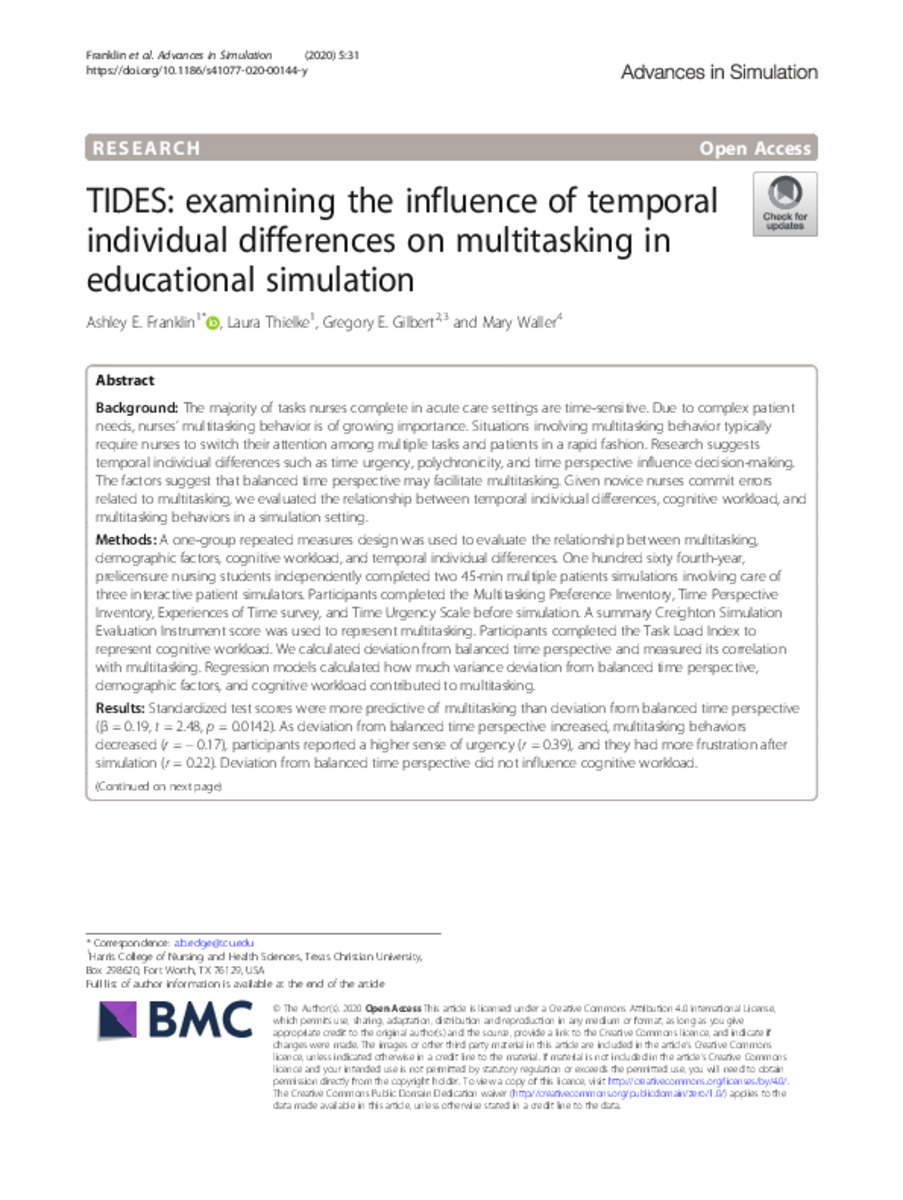TIDES: examining the influence of temporal individual differences on multitasking in educational simulationShow full item record
| Title | TIDES: examining the influence of temporal individual differences on multitasking in educational simulation |
|---|---|
| Author | Franklin, Ashley E.; Thielke, Laura; Gilbert, Gregory E.; Waller, Mary |
| Date | 2020-11-09 |
| Abstract | Background: The majority of tasks nurses complete in acute care settings are time-sensitive. Due to complex patient needs, nurses’ multitasking behavior is of growing importance. Situations involving multitasking behavior typically require nurses to switch their attention among multiple tasks and patients in a rapid fashion. Research suggests temporal individual differences such as time urgency, polychronicity, and time perspective influence decision-making. The factors suggest that balanced time perspective may facilitate multitasking. Given novice nurses commit errors related to multitasking, we evaluated the relationship between temporal individual differences, cognitive workload, and multitasking behaviors in a simulation setting. Methods: A one-group repeated measures design was used to evaluate the relationship between multitasking, demographic factors, cognitive workload, and temporal individual differences. One hundred sixty fourth-year, prelicensure nursing students independently completed two 45-min multiple patients simulations involving care of three interactive patient simulators. Participants completed the Multitasking Preference Inventory, Time Perspective Inventory, Experiences of Time survey, and Time Urgency Scale before simulation. A summary Creighton Simulation Evaluation Instrument score was used to represent multitasking. Participants completed the Task Load Index to represent cognitive workload. We calculated deviation from balanced time perspective and measured its correlation with multitasking. Regression models calculated how much variance deviation from balanced time perspective, demographic factors, and cognitive workload contributed to multitasking. Results: Standardized test scores were more predictive of multitasking than deviation from balanced time perspective (ß = 0.19, t = 2.48, p = 0.0142). As deviation from balanced time perspective increased, multitasking behaviors decreased (r = -0.17), participants reported a higher sense of urgency (r = 0.39), and they had more frustration after simulation (r = 0.22). Deviation from balanced time perspective did not influence cognitive workload. Conclusions: Nursing students who demonstrate multitasking behaviors tend to have a more balanced time perspective. Knowing students’ deviation from balanced time perspective may help educators anticipate who will need more assistance with multitasking in simulation. Nursing students frequently wait until just before graduation to provide care for multiple patients; including mention of deviation from balanced time perspective in simulation preparation may help senior nursing students become more self-aware and ultimately improve behavioral performance. |
| Link | https://doi.org/10.1186/s41077-020-00144-y
https://repository.tcu.edu/handle/116099117/42624 https://advancesinsimulation.biomedcentral.com/articles/10.1186/s41077-020-00144-y |
| Department | Nursing |
| Subject | Multitasking
Temporal individual differences Simulation Balanced time perspective Cognitive workload |
Files in this item
This item appears in the following Collection(s)
- Research Publications [1008]
© TCU Library 2015 | Contact Special Collections |
HTML Sitemap




